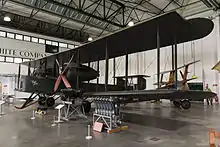NIVO
NIVO, abbreviated from Night Invisible Varnish Orfordness (or "Night Varnish Orfordness"),[2] was a dark grey-green overall finish applied to British night bomber aircraft in the inter-war period (1918-1939).

| NIVO | |
|---|---|
| Hex triplet | #404735 |
| sRGBB (r, g, b) | (64, 71, 53) |
| HSV (h, s, v) | (83°, 25%, 28%) |
| CIELChuv (L, C, h) | (29, 12, 104°) |
| Source | Federal Standard 595[1] |
| B: Normalized to [0–255] (byte) | |
Developed in 1918 by the experimental station at Orford Ness, as a low-visibility colouring for the Royal Air Force it had a sheen to match that of open water on a moonlit night.[3]
It was applied to aircraft from 1918 and was used on the Vickers Virginia, Handley Page Hyderabad, Handley Page Hinaidi, Handley Page Heyfords and Fairey Hendon bombers.
By the mid 1930s, tests had determined that the varnish was too reflective when searchlights were shone on it.[3] NIVO was phased out in the late 1930s, and had been discontinued by the time of the arrival of the new British medium bombers - the Vickers Wellington, Handley Page Hampden and Armstrong Whitworth Whitley.
NIVO is covered by Federal Standard 595 colour FS:34096[4][5]
References
- "Federal Standard 595 Color FS 34096". IPMSStockholm.org. IPMS Stockholm. Retrieved 18 January 2022.
- Kinsey, Gordon (1 March 1992). Boulton & Paul Aircraft. Terence Dalton Limited. p. 172. ISBN 978-0861380855.
- Richardson, Doug (11 October 2001). Stealth Warplanes: Deception, Evasion, and Concealment in the Air. Zenith Press. pp. 15–16. ISBN 0-7603-1051-3.
- "Urban's Colour Reference Charts". IPMSStockholm.org. IPMS Stockholm. Retrieved 18 January 2022.
- "British Military Colours 1940 to date". vicflintham.co.uk. Archived from the original on 23 October 2013.